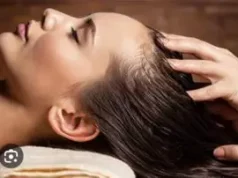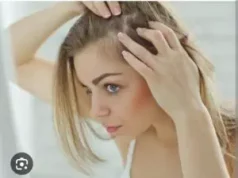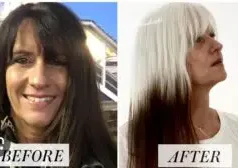Understanding the Hair Growth Cycle
The hair growth cycle can be broken down into three main phases: anagen, catagen, and telogen. Understanding each phase is essential to promote hair growth effectively.
- Anagen phase: This is the active growth phase, during which the hair follicle produces hair. The length of this phase varies from person to person, and it can last between two to six years.
- Catagen phase: During this transitional phase, the hair follicle shrinks, and hair growth stops. This phase lasts about two weeks.
- Telogen phase: This is the resting phase during which the hair follicle remains dormant for about three months before shedding the old hair and starting a new anagen phase.
By understanding the hair growth cycle, you can develop a hair care routine that promotes healthy hair growth by minimizing hair shedding, stimulating hair follicles, and supporting the growth of new hair.
1. Maintaining a Healthy Scalp
Maintaining a healthy scalp is crucial to promoting hair growth. A healthy scalp provides the foundation for strong and healthy hair. Here are some tips for maintaining a healthy scalp:
- Keep your scalp clean: Washing your hair regularly can help remove excess oil, dirt, and product buildup, which can clog hair follicles and inhibit hair growth.
- Use a gentle shampoo: Choose a shampoo that is gentle and free from harsh chemicals that can damage hair and scalp. Look for products that are specifically formulated for your hair type.
- Condition your hair regularly: Conditioning your hair can help keep it moisturized and prevent breakage. Be sure to focus on the ends of your hair, as this is the oldest part of your hair and is more prone to damage.
- Avoid hot tools: Heat styling tools can damage your hair and scalp, leading to hair breakage and loss. If you must use hot tools, use them sparingly and always use a heat protectant.
- Protect your scalp from the sun: Excessive exposure to the sun can damage your scalp and hair. Wear a hat or scarf to protect your scalp from the sun’s harmful rays.
- Avoid tight hairstyles: Tight hairstyles like braids, ponytails, and buns can pull on your hair and scalp, leading to hair breakage and loss. Opt for looser styles that don’t put too much tension on your hair.
By following these tips, you can maintain a healthy scalp and promote healthy hair growth.
2. Adopting a Balanced Diet
Adopting a balanced diet is crucial to promoting healthy hair growth. Your hair needs proper nutrition to grow strong and healthy. Here are some nutrients that are essential for healthy hair growth:
- Protein: Hair is made up of a protein called keratin. Eating a diet rich in protein can help support healthy hair growth. Good sources of protein include lean meats, fish, poultry, beans, and lentils.
- Iron: Iron helps carry oxygen to the hair follicles, which is essential for healthy hair growth. Good sources of iron include red meat, poultry, fish, beans, and spinach.
- Vitamins B and C: Vitamins B and C help support the production of collagen, which is essential for healthy hair growth. Good sources of vitamin B include whole grains, eggs, and nuts. Good sources of vitamin C include citrus fruits, berries, and peppers.
- Omega-3 fatty acids: Omega-3 fatty acids help nourish hair follicles and promote healthy hair growth. Good sources of omega-3 fatty acids include fatty fish, nuts, and seeds.
- Water: Drinking enough water is essential for healthy hair growth. It helps keep your hair and scalp hydrated, which is essential for healthy hair growth.
By adopting a balanced diet that is rich in these nutrients, you can promote healthy hair growth from the inside out.
Also Read: How To prepare Onion Juice For hair growth
3. Avoiding Damaging Hair Practices
Avoiding damaging hair practices is essential to promote healthy hair growth. Here are some common hair practices that can damage your hair and scalp:
- Using hot tools: Heat styling tools like hair dryers, straighteners, and curling irons can damage your hair and scalp, leading to hair breakage and loss. Try to limit your use of these tools and always use a heat protectant.
- Overwashing your hair: Washing your hair too often can strip it of its natural oils, which can make it dry and brittle. Try to wash your hair every other day or every few days, depending on your hair type.
- Using harsh chemicals: Chemical treatments like hair dyes, perms, and relaxers can damage your hair and scalp, leading to hair breakage and loss. Try to limit your use of these treatments or opt for gentler, natural alternatives.
- Brushing wet hair: Wet hair is more prone to breakage than dry hair, so avoid brushing your hair when it’s wet. Instead, use a wide-tooth comb to gently detangle your hair.
- Tying your hair too tightly: Tying your hair too tightly in a ponytail or bun can pull on your hair and scalp, leading to hair breakage and loss. Opt for looser hairstyles that don’t put too much tension on your hair.
- Using harsh hair accessories: Using hair accessories like rubber bands and metal clips can damage your hair and scalp, leading to hair breakage and loss. Opt for gentler accessories like fabric-covered hair ties and plastic clips.
By avoiding these damaging hair practices, you can promote healthy hair growth and maintain strong, healthy hair.
4. Using Hair Growth Products and Treatments
Using hair growth products and treatments can be a helpful addition to your hair care routine to promote healthy hair growth. Here are some options to consider:
- Hair growth supplements: Supplements that contain biotin, vitamin D, and other essential nutrients can help support healthy hair growth. Consult with a healthcare professional before adding supplements to your routine.
- Topical treatments: Topical treatments like minoxidil can help stimulate hair growth by increasing blood flow to the scalp. Consult with a dermatologist to determine if this treatment is right for you.
- Scalp massage: Massaging your scalp can help increase blood flow to the hair follicles, which can promote healthy hair growth. Use your fingertips to massage your scalp for a few minutes each day.
- Essential oils: Essential oils like peppermint, rosemary, and lavender can help stimulate hair growth by improving blood circulation to the scalp. Dilute the essential oil in a carrier oil like coconut oil before applying it to your scalp.
- Laser therapy: Low-level laser therapy can help stimulate hair growth by increasing blood flow to the hair follicles. Consult with a dermatologist to determine if this treatment is right for you.
It’s essential to note that while hair growth products and treatments can be helpful, they’re not a substitute for a healthy diet, proper hair care, and overall good health. Be sure to consult with a healthcare professional before adding any new products or treatments to your routine.
5. Massaging the Scalp to Stimulate Hair Growth
Massaging the scalp is a simple and effective way to stimulate hair growth. Here are some ways scalp massage can help:
- Increase blood flow: Massaging the scalp can help increase blood flow to the hair follicles, which can promote healthy hair growth.
- Release tension: Scalp massage can help release tension in the scalp muscles, which can help improve circulation and promote healthy hair growth.
- Distribute natural oils: Massaging the scalp can help distribute the natural oils produced by the scalp throughout the hair, which can help keep hair healthy and hydrated.
Here’s how to massage your scalp:
- Use your fingertips: Use the tips of your fingers to massage your scalp. Avoid using your nails, as this can scratch the scalp.
- Apply gentle pressure: Apply gentle pressure and move your fingertips in circular motions. Start at the front of your scalp and work your way to the back.
- Massage for a few minutes: Massage your scalp for a few minutes each day, preferably before bed or in the shower.
- Use essential oils: You can add a few drops of essential oils like peppermint, rosemary, or lavender to a carrier oil like coconut oil before massaging it into your scalp for added benefits.
Scalp massage is a simple and relaxing way to promote healthy hair growth, so make it a regular part of your hair care routine.
Also Read : How to prepare Clove Water For Hair Growth
6. Protecting Hair from Environmental Stressors
Protecting your hair from environmental stressors is essential to maintain healthy hair growth. Here are some common environmental stressors and tips to protect your hair from them:
- Sun damage: Sun exposure can damage your hair by drying it out and causing it to become brittle. Protect your hair from the sun by wearing a hat or scarf, or using a hair product that contains SPF.
- Pollution: Pollution can cause hair to become dry and brittle, as well as contribute to hair loss. Protect your hair by wearing a hat or scarf in polluted areas, and consider using a clarifying shampoo to remove buildup.
- Chlorine and saltwater: Chlorine and saltwater can be damaging to hair by stripping it of its natural oils. Protect your hair by wearing a swimming cap or wetting your hair with clean water before swimming.
- Heat and humidity: Heat and humidity can cause hair to become frizzy and dry. Protect your hair by using a heat protectant when using hot tools and using a leave-in conditioner to keep your hair hydrated.
- Cold weather: Cold weather can cause hair to become dry and brittle. Protect your hair by wearing a hat or scarf, and use a deep conditioning treatment to keep your hair hydrated.
By protecting your hair from environmental stressors, you can maintain healthy hair growth and keep your hair looking and feeling its best.
7. Managing Stress and Getting Enough Sleep
Managing stress and getting enough sleep are essential factors for healthy hair growth. Here’s how they can impact your hair health and some tips to manage stress and improve sleep:
- Stress: Stress can cause hair loss, as well as make hair look dull and lifeless. Stress can also cause scalp problems like dandruff and psoriasis. Managing stress is crucial for healthy hair growth.
Tips for managing stress:
- Practice relaxation techniques like deep breathing or meditation.
- Engage in regular physical activity like yoga or walking.
- Take breaks during the day to rest and recharge.
- Prioritize self-care activities like taking a bath, reading, or listening to music.
- Sleep: Lack of sleep can impact the health of your hair by reducing its strength and causing hair loss. During sleep, the body repairs and regenerates cells, including hair cells.
Tips for improving sleep:
- Set a consistent sleep schedule and stick to it.
- Create a relaxing sleep environment by reducing noise and light.
- Avoid using electronic devices before bedtime, as they can interfere with sleep.
- Practice relaxation techniques like meditation or deep breathing to promote relaxation before sleep.
By managing stress and getting enough sleep, you can improve the overall health of your hair and promote healthy hair growth.
Also Read: How to Prepare Neem Leaves For Hair Growth
8. Trimming Hair Regularly to Promote Growth
Trimming your hair regularly is an important step in promoting healthy hair growth. Here’s how trimming your hair can help and some tips for getting the most out of your haircuts:
- Prevents split ends: Split ends can cause hair to break and become damaged, which can slow down hair growth. Trimming your hair regularly can prevent split ends from occurring and help your hair grow longer and healthier.
- Promotes healthy hair: Regular haircuts can help remove damaged and unhealthy hair, promoting the growth of healthier hair.
Tips for getting the most out of your haircuts:
- Schedule regular haircuts: Aim to get a trim every six to eight weeks to keep your hair healthy and prevent split ends.
- Communicate with your hairstylist: Let your hairstylist know your hair goals, whether it’s growing your hair out or maintaining a certain length. They can help you achieve your hair goals and offer advice on hair care and styling.
- Be mindful of the length you cut: Only trim off the ends of your hair, about a quarter-inch to a half-inch, to maintain healthy hair while still achieving hair growth.
- Use hair care products to maintain healthy hair: Use quality hair care products like shampoos and conditioners that are designed for your hair type to maintain healthy hair in between haircuts.
Regular haircuts are an important step in promoting healthy hair growth, so be sure to schedule them regularly and communicate with your hairstylist to achieve your hair goals.
9. Being Patient and Consistent in Hair Care
Being patient and consistent in your hair care routine is important for promoting healthy hair growth. Here are some tips for staying patient and consistent with your hair care:
- Understand that hair growth takes time: Hair typically grows around half an inch per month, so it may take several months or even years to achieve your desired length. Be patient and don’t get discouraged if you don’t see results immediately.
- Develop a consistent hair care routine: Consistency is key when it comes to hair care. Develop a routine that works for you, including washing and conditioning your hair regularly, using hair care products that are suitable for your hair type, and avoiding damaging hair practices.
- Monitor your hair growth progress: Take pictures of your hair regularly to monitor your progress. This will help you see how your hair is growing and identify any areas that may need extra attention.
- Be mindful of changes in your hair: Pay attention to any changes in your hair, such as excessive shedding or breakage. This can be a sign that your hair care routine needs adjustment.
- Stay motivated: Keep your hair growth goals in mind and stay motivated. Surround yourself with positive influences, such as hair growth communities or support groups, to help you stay motivated and on track.
By being patient and consistent in your hair care routine, you can promote healthy hair growth and achieve your hair goals. Remember that healthy hair growth takes time, but with consistency and patience, you can achieve the long, healthy hair you desire.






